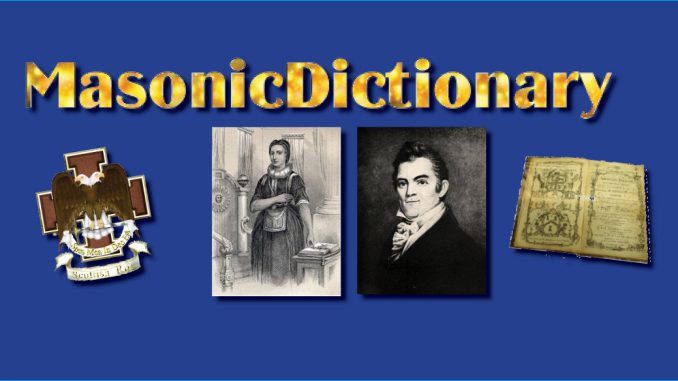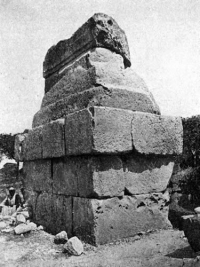
 Five miles to the East of the City of Tyre is an ancient monument, called by the natives Kabr Hairan, or the Comb of Hiram. The tradition that the King of Tyre was there interred rests only on the authority of the natives. It bears about it, however, the unmistakable marks of extreme antiquity, and, as Thompson says (The Land and The Boots, page 196), there is nothing in the monument itself inconsistent with the idea that it marks the final resting-place of that friend of Solomon. He thus describes it:
Five miles to the East of the City of Tyre is an ancient monument, called by the natives Kabr Hairan, or the Comb of Hiram. The tradition that the King of Tyre was there interred rests only on the authority of the natives. It bears about it, however, the unmistakable marks of extreme antiquity, and, as Thompson says (The Land and The Boots, page 196), there is nothing in the monument itself inconsistent with the idea that it marks the final resting-place of that friend of Solomon. He thus describes it:
“The base consists of two tiers of great stones, each three feet thick, thirteen feet long, and eight feet eight inches broad. Above this is one huge stone, a little more than fifteen feet long, ten broad, and three feet four inches thick. Over this is another, twelve feet three inches long eight broad, and six high. The top stone is a little smaller every way, and only five feet thick. The entire height is twenty-one feet. There is nothing like it in this country, and it may even have stood, as it now does, ever since the days of Solomon. These large broken sarcophagi scattered around it are assigned by tradition to Hiram’s mother wife, and family.”
Doctor Morris, who visited the spot in 1868, gives a different measurement, which is probably more accurate than that of Thompson. According to him, the first tier is 14 feet long, 8 feet 8 inches broad, 4 feet thick. Second tier, 14 feet long, 8 feet 8 inches broad, 2 feet 10 inches thick. Third tier, 15 feet 1 inch long, 9 feet 11 inches broad, 2 feet 11 inches thick. Fourth tier, 12 feet 11 inches long, 7 feet 8 inches broad, 6 feet 5 inches thick. Fifth tier, 12 feet 11 inches long, 7 feet 8 inches broad. and 3 feet 6 inches thick. He makes the height of the whole 19 feet 8 inches. Travelers have been disposed to give more credit to the tradition which makes this monument the tomb of the King of Tyre than to most of the other legends which refer to ancient sepulchers in the Holy Land.
– Source: Mackey’s Encyclopedia of Freemasonry
Is this Hiram’s final resting place
An article in the April, 1926 issue of Masonic Tidings no doubt created a great deal of excitement in Masonic circles of the day.
For the headline and article implied that perhaps the tomb of King Hiram of Tyre may well have been found a few miles outside of Tyre.
“Preparations which are now beginning made in London for extended exploration and excavation of and about the alleged site of King Hiram’s tomb will be watched closely by Masonic scholars as well as by archeologists,” wrote the author.
According to local traditions the tomb, which measures 14 feet long by 8 feet 8 inches wide at its largest point was the final resting place of either King Hiram I or Hiram, the architect of biblical and Masonic fame.
Although the tomb was made known to a wide Masonic audience in the first two decades of the 20th Century through articles in magazines such as Masonic Tidings and The Builder, it was not unknown to Masons of an earlier age. Robert Morris wrote of it in his book, Freemasonry in the Holy Land after having first seen the tomb in 1868, when he visited the region. In fact, Morris decided to add his own personal touch to the ancient tomb, which only served to confuse at least one Masonic writer.
In his article The Pillars and the Porch, which appeared in the April 1917 issue of The Builder, John W. Barry wrote the following words.
“To the right will he noticed a square and compass cut in the rock, but by whom and when are questions that cannot be answered.”
Had Brother Barry read Brother Morris’ book he would have known by whom and when. Morris when visiting the archeological site decided to carve the Square and Compasses upon the tomb-an act of vandalism that would certainly not be tolerated today.
Many years later scholars are still unsure of the origins of the sarcophagus, but generally dispute that it was the final resting place of either Hiram.
Excavations in 1922-some years prior to the Masonic Tidings article-discovered a few interesting artifacts. Among them was an Egyptian vase with a cartouche of Rameses II on it as well as Cypriot pottery, which dated the location to much more recent times than the Phoenician era.
It would seem that Morris’ Masonic graffiti may be the only Masonic connection still extant.
-Source: Masonic Magazine Issue No. 5
